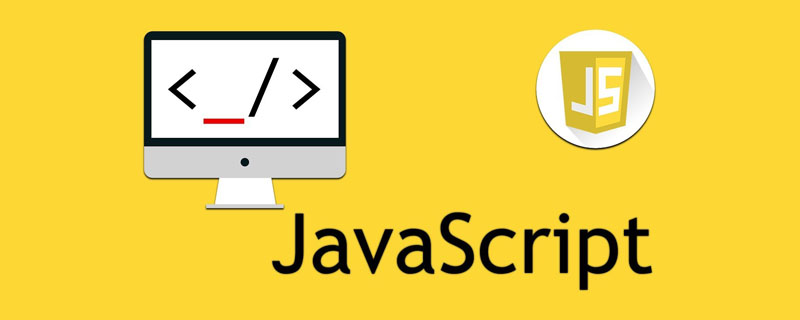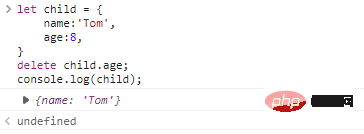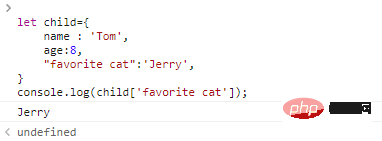Master JavaScript objects in one article
This article brings you relevant knowledge about javascript, which mainly introduces issues related to objects, including object-oriented, object operations, property naming, etc. Let’s talk about it together Take a look, hope it helps everyone.

[Related recommendations: javascript video tutorial, web front-end】
JavaScript Object# Eight data types of
##JavaScript, including seven primitive data types (Number, BigInt, String , Boolean, null, undefined, and symbol) and a complex type object (also is the object type).
object is called a complex type because primitive types can only represent one type of data, such as Number represents a number. String represents strings, etc., while object can contain all primitive data types in the form of key-value pairs.
symbol type to represent the object's ID, the String type to represent the object's name, and the Boolean indicates the gender of the object, etc. Each type of data in the object is called an attribute of the object. An object can theoretically have countless attributes, which are unified in a pair of curly braces{...}# Created in ##.
is not only a language feature of JavaScript, but also in all object-oriented languages, such as C , Java , Python, C# are all very important concepts. If you want to learn JavaScript well, you must be proficient or even proficient in the characteristics of objects, because objects penetrate all aspects of JavaScript. Object-oriented VS process-oriented
Object-oriented is a programming idea, not a new technology. Before object-oriented was born, programmers organized large amounts of code with process-oriented thinking.
What is object-oriented? This question is often asked in schools and interviews. We can understand the answer very profoundly:
Everything is an object. Although this is absolutely correct, it is not the answer that the interviewer or teacher wants. Object-oriented is a programming idea, a way of organizing code, which is relative to
Process-oriented. In process-oriented, the programmer is God, and God directs and directs everything. For example, we often give an example: putting an elephant in the refrigerator. In the process of facing God, you need to open the refrigerator door first, then put the elephant into the refrigerator, and finally close the refrigerator door. All processes are operated by God alone. In object-oriented, the refrigerator and the elephant are both existing objects, and the refrigerator will open the door by itself, the elephant will enter the refrigerator by itself, and then the refrigerator will close the door by itself. The whole process is coordinated by God, but the specific process of doing things is completed by the subject himself, such as how to open the refrigerator door, how to enter the refrigerator, etc.
Syntax
You don’t need to use keywords to define an object. You can create an object by wrapping the key-value pair in curly braces
{..}. The syntax is as follows: <div class="code" style="position:relative; padding:0px; margin:0px;"><pre class="brush:php;toolbar:false">let child = {
name:'Tom',
age:8,}</pre><div class="contentsignin">Copy after login</div></div>The above code creates a simple object and assigns the object to the variable
. The child object has two attributes (two values), one is name, the other is age. The so-called key-value pair (key:value
) is a simple mapping between names and values. For example, name:'Tom'
in the above example is a key-value pair, where name is the key and "Tom" is the corresponding value. In actual use, the corresponding value can be obtained through the key, just like using the variable name to obtain the variable value. Empty object
If an object does not have any attributes, then the object is an empty object. We can obtain an empty object by simply assigning
{} to a variable, or we can use another method: <div class="code" style="position:relative; padding:0px; margin:0px;"><pre class="brush:php;toolbar:false">let nullObj1 = {};
//创建也给空的对象let nullObj2 = new Object();
//同样创建了一个空对象</pre><div class="contentsignin">Copy after login</div></div>Object operation
After an object is created, It is not static. When we use the object, we can query the properties of the object or change the object at any time.
Query attributes
To query the attribute value of an object, you need to use a new symbol:
., and the syntax is object name.variable name. Give a simple example:
let child = {
name:'Tom',
age:8,};console.log(child.name);console.log(child.age)The code execution result is as follows:
 In the above case, if we want to view the variables For the
In the above case, if we want to view the variables For the
attribute in child, you only need to simply use child.name. <h3 id="增加属性">增加属性</h3>
<p>在一个对象变量创建完成后,我们还可以随时向变量中添加新的属性,方法如下:</p>
<div class="code" style="position:relative; padding:0px; margin:0px;"><pre class="brush:php;toolbar:false">let child = {
name:'Tom',
age:8,}child.height = 800;//创建了一个新的属性heightconsole.log(child.height);</pre><div class="contentsignin">Copy after login</div></div>
<p>代码执行结果如下:<br><img src="/static/imghw/default1.png" data-src="https://img.php.cn/upload/article/000/000/067/fe2059ee460429c7555eaf109d8f6ba7-1.png" class="lazy" alt=""></p>
<p>向对象变量中添加新的属性,只需要直接使用<code>.属性名,然后直接向新属性赋值即可。
如果我们此时查看变量child的内容,可以发现height属性已经位列其中了:

对象的属性类型可以是任意的,我们可以直接使用child.isBoy=true向对象中添加布尔值,或者使用child.money=null添加一个值为空的属性。
更改属性
JavaScript对象更改属性值也非常简单,直接向变量赋值就可以了,举个简单的小李子:
let child={
name:'Tom',
age:8,}child.age=12;console.log(child);代码执行结果如下:

可以看到,age变量已经从8变成了12。
删除属性
对象删除属性需要使用一个新的关键字delete,使用delet 对象名.属性名删除对象的属性:
let child = {
name:'Tom',
age:8,}delete child.age;console.log(child);代码执行结果如下:

从代码的执行结果可以看到属性age已经被删掉了。
多单词键值
对象的属性名(键)还能够使用空格隔开的多个单词,不过在创建此类属性时需要使用双引号把键名包裹起来。
举个例子:
let child={
name = 'Tom',
age:8,
"favorite cat":'Jerry',}以上代码就创建了一个键名为"favorite cat"的键值对,但是在访问属性值的时候,如果使用:
child.favorite cat = 'Bob'; //语法错误
这种方式是错误的,引擎会把favorite当作一个键名,并在遇到cat时报错。
访问此类键值,就需要方括号。
方括号
.可以访问普通的属性名,在例如"favorite cat"之类的变量时可以使用[],举个例子:
let child={
name:'Tom',
age:8,
"favorite cat":'Jerry',}console.log(child['favorite cat']);代码执行结果如下:

方括号提供了.之外的属性访问方式,我们完全可以通过方括号代替.来操作对象的属性。
例如:
let child = {
name:'Tom',
age:8,}child['favorite cat']='Jerry';
//增加属性child['name']='Bob';
//修改属性delete child['age'];
//删除数console.log(child['name']);
//查看属性除了常规的属性操作之外,方括号还能通过变量访问对象属性:
let child = {
name:'Tom',
age:8,}let prop = 'name';console.log(child[prop]);prop='age';console.log(child[prop]);通过变量访问属性值的能力为我们提供了非常有用的变量访问方式,例如我们可以在程序中计算出属性的键名,然后再通过键名访问键值。
举个栗子:
let child = {
prop1:0,
prop2:1,
prop3:2,}let prop = 'prop';for(let i=1;i<p>在这里,范围属性值的<code>key</code>是通过计算得到的,这一功能用<code>.</code>是不能实现的。</p><h2 id="计算属性">计算属性</h2><p>在创建对象时,我们还可以通过变量指定对象的键名,此类属性叫做<strong>计算属性</strong>。</p><p>举个例子:</p><pre class="brush:php;toolbar:false">let propName = 'name';let child ={
[propName]:'Tom',
age:8,}代码执行结果如下:
> let propName = 'name';
> let child ={
[propName]:'Tom',
age:8,
> }
> undefined
> child
> {name: 'Tom', age: 8}上例中的[propName]就是一个计算属性,意义也非常简单,就是使用变量propName中存储的值(此处为"name")作为对象的键名。
以上的代码本质上和下面的代码作用相同:
let propName='name';let child = {
age:8,}child[propName]='Tom';方括号中还可以使用复杂的表达式:
let child = {['prop' + 2 * 3]:'Tom',}代码执行结果如下:
> let child = {
['prop'+2*3]:'Tom',
} child<h2 id="属性简写">属性简写</h2><p>在实际应用中,或者匿名对象中,我们常常会使用和变量同名的属性,举个例子:</p><pre class="brush:php;toolbar:false">let name = 'Tom';let age = 8;let child = {
name:name, //属性名和变量名一样,都是name
age:age,};这种情况下,我们就可以简写对象属性,如下:
let name = 'Tom';let age = 8;let child = {
name, // 等同于name:name;
age,}代码的执行结果:
> let name = 'Tom';
let age = 8;
let child = {
name,
age,
} child<h2 id="属性命名">属性命名</h2><p>和变量命名不同,我们几乎可以使用任何值作为属性的名称,包括关键字和数字:</p><h3 id="关键字作为变量名">关键字作为变量名</h3><p>虽然听起来不可思议,实际上,所有的关键字都可以作为对象的属性名:</p><pre class="brush:php;toolbar:false">let obj = {
for:0,
while:1,
function:2,
alert:3,}代码执行结果:
> let obj = {
for:0,
while:1,
function:2,
alert:3,
} obj<h3 id="数字作为关键字">数字作为关键字</h3><p>数字也可以作为关键字的名称,如下:</p><pre class="brush:php;toolbar:false">let obj = {
0:'Number',//隐式转换为"0"
1:'Number',}console.log(obj['0']);数字作为属性名称时,会被隐式转换为字符串,在访问属性时,不能使用.,必须使用方括号代替。
属性名称中的陷阱
在命名中,有一个小陷阱,我们不能使用__proto__作为属性的名称,这个属性是对象的一个特殊,后继会特别介绍。
举个例子:
let obj = {};obj.__proto__ = 1;console.log(obj.__proto__);
in 操作符
JavaScript有一个需要注意的特性,即使访问一个不存的属性时也不会报错,仅仅是返回undefined。
那我们如何知道,属性是否存在于对象之中呢?
最简单的方式是使用if语句:
let obj = {};if(obj.someProp === undefined){
...}这么做在大部分情况下是没有问题的,但是当属性名称的值就是undefined本身时,就会出现错误:
let obj = {
prop : undefined}obj.prop === undefined ? console.log('no'):console.log('yes');代码执行结果:
> let obj = {
prop : undefined
}
obj.prop === undefined ? console.log('no'):console.log('yes');
no<p>虽然<code>prop</code>是存在的,但是以上案例并不能正确的返回结果。</p><p>这个时候就需要使用<code>in</code></p><pre class="brush:php;toolbar:false">let obj = {
prop:undefined,};if('prop' in obj){
console.log('yes');}else{
console.log('no');}这么做是不是优雅了许多呢?
> let obj = {
prop:undefined,
};
if('prop' in obj){
console.log('yes');
}else{
console.log('no');
}<h2 id="属性遍历">属性遍历</h2><p>如果我们不知道对象中都存在什么属性,如何取得所有的属性值呢?<br> 这时候就需要使用<code>for .. in ..</code>语句了,它类似于<code>for</code>循环,但是更简洁。</p><p><strong>语法</strong></p><pre class="brush:php;toolbar:false">for (key in obj){
...}举个简单的小李子:
let child = {
name:'Tom',
age:8,
height:180,}for (let key in child){
console.log(key+':'+child[key]);}代码执行结果如下:
> let child = {
name:'Tom',
age:8,
height:180,
}
for (let key in child){
console.log(key+':'+child[key]);
}<h2 id="属性顺序">属性顺序</h2><p>当我们创建一个对象并遍历其中所有的属性时,属性是如何排列的呢?答案是:特别的顺序排列,并遵循以下规则:</p><ol>
<li>数字属性以数字顺序排列;</li>
<li>其他属性按照创建顺序排列;</li>
<li>数字属性在其他属性之前;</li>
</ol><p>举个例子:</p><pre class="brush:php;toolbar:false">let obj = {
name:'Tom',
age:99,
7:'7',
1:'1',
9:'9',}for (let key in obj){
console.log(key+':'+obj[key]);}代码执行结果:
> let obj = {
name:'Tom',
age:99,
7:'7',
1:'1',
9:'9',
}
for (let key in obj){
console.log(key+':'+obj[key]);
}<p>【相关推荐:<a href="https://www.php.cn/course/list/17.html" target="_blank" textvalue="javascript视频教程">javascript视频教程</a>、<a href="https://www.php.cn/course/list/1.html" target="_blank">web前端</a>】</p>The above is the detailed content of Master JavaScript objects in one article. For more information, please follow other related articles on the PHP Chinese website!

Hot AI Tools

Undresser.AI Undress
AI-powered app for creating realistic nude photos

AI Clothes Remover
Online AI tool for removing clothes from photos.

Undress AI Tool
Undress images for free

Clothoff.io
AI clothes remover

Video Face Swap
Swap faces in any video effortlessly with our completely free AI face swap tool!

Hot Article

Hot Tools

Notepad++7.3.1
Easy-to-use and free code editor

SublimeText3 Chinese version
Chinese version, very easy to use

Zend Studio 13.0.1
Powerful PHP integrated development environment

Dreamweaver CS6
Visual web development tools

SublimeText3 Mac version
God-level code editing software (SublimeText3)

Hot Topics
 1386
1386
 52
52
 How to implement an online speech recognition system using WebSocket and JavaScript
Dec 17, 2023 pm 02:54 PM
How to implement an online speech recognition system using WebSocket and JavaScript
Dec 17, 2023 pm 02:54 PM
How to use WebSocket and JavaScript to implement an online speech recognition system Introduction: With the continuous development of technology, speech recognition technology has become an important part of the field of artificial intelligence. The online speech recognition system based on WebSocket and JavaScript has the characteristics of low latency, real-time and cross-platform, and has become a widely used solution. This article will introduce how to use WebSocket and JavaScript to implement an online speech recognition system.
 WebSocket and JavaScript: key technologies for implementing real-time monitoring systems
Dec 17, 2023 pm 05:30 PM
WebSocket and JavaScript: key technologies for implementing real-time monitoring systems
Dec 17, 2023 pm 05:30 PM
WebSocket and JavaScript: Key technologies for realizing real-time monitoring systems Introduction: With the rapid development of Internet technology, real-time monitoring systems have been widely used in various fields. One of the key technologies to achieve real-time monitoring is the combination of WebSocket and JavaScript. This article will introduce the application of WebSocket and JavaScript in real-time monitoring systems, give code examples, and explain their implementation principles in detail. 1. WebSocket technology
 How to use JavaScript and WebSocket to implement a real-time online ordering system
Dec 17, 2023 pm 12:09 PM
How to use JavaScript and WebSocket to implement a real-time online ordering system
Dec 17, 2023 pm 12:09 PM
Introduction to how to use JavaScript and WebSocket to implement a real-time online ordering system: With the popularity of the Internet and the advancement of technology, more and more restaurants have begun to provide online ordering services. In order to implement a real-time online ordering system, we can use JavaScript and WebSocket technology. WebSocket is a full-duplex communication protocol based on the TCP protocol, which can realize real-time two-way communication between the client and the server. In the real-time online ordering system, when the user selects dishes and places an order
 How to implement an online reservation system using WebSocket and JavaScript
Dec 17, 2023 am 09:39 AM
How to implement an online reservation system using WebSocket and JavaScript
Dec 17, 2023 am 09:39 AM
How to use WebSocket and JavaScript to implement an online reservation system. In today's digital era, more and more businesses and services need to provide online reservation functions. It is crucial to implement an efficient and real-time online reservation system. This article will introduce how to use WebSocket and JavaScript to implement an online reservation system, and provide specific code examples. 1. What is WebSocket? WebSocket is a full-duplex method on a single TCP connection.
 JavaScript and WebSocket: Building an efficient real-time weather forecasting system
Dec 17, 2023 pm 05:13 PM
JavaScript and WebSocket: Building an efficient real-time weather forecasting system
Dec 17, 2023 pm 05:13 PM
JavaScript and WebSocket: Building an efficient real-time weather forecast system Introduction: Today, the accuracy of weather forecasts is of great significance to daily life and decision-making. As technology develops, we can provide more accurate and reliable weather forecasts by obtaining weather data in real time. In this article, we will learn how to use JavaScript and WebSocket technology to build an efficient real-time weather forecast system. This article will demonstrate the implementation process through specific code examples. We
 Simple JavaScript Tutorial: How to Get HTTP Status Code
Jan 05, 2024 pm 06:08 PM
Simple JavaScript Tutorial: How to Get HTTP Status Code
Jan 05, 2024 pm 06:08 PM
JavaScript tutorial: How to get HTTP status code, specific code examples are required. Preface: In web development, data interaction with the server is often involved. When communicating with the server, we often need to obtain the returned HTTP status code to determine whether the operation is successful, and perform corresponding processing based on different status codes. This article will teach you how to use JavaScript to obtain HTTP status codes and provide some practical code examples. Using XMLHttpRequest
 How to use insertBefore in javascript
Nov 24, 2023 am 11:56 AM
How to use insertBefore in javascript
Nov 24, 2023 am 11:56 AM
Usage: In JavaScript, the insertBefore() method is used to insert a new node in the DOM tree. This method requires two parameters: the new node to be inserted and the reference node (that is, the node where the new node will be inserted).
 JavaScript and WebSocket: Building an efficient real-time image processing system
Dec 17, 2023 am 08:41 AM
JavaScript and WebSocket: Building an efficient real-time image processing system
Dec 17, 2023 am 08:41 AM
JavaScript is a programming language widely used in web development, while WebSocket is a network protocol used for real-time communication. Combining the powerful functions of the two, we can create an efficient real-time image processing system. This article will introduce how to implement this system using JavaScript and WebSocket, and provide specific code examples. First, we need to clarify the requirements and goals of the real-time image processing system. Suppose we have a camera device that can collect real-time image data




